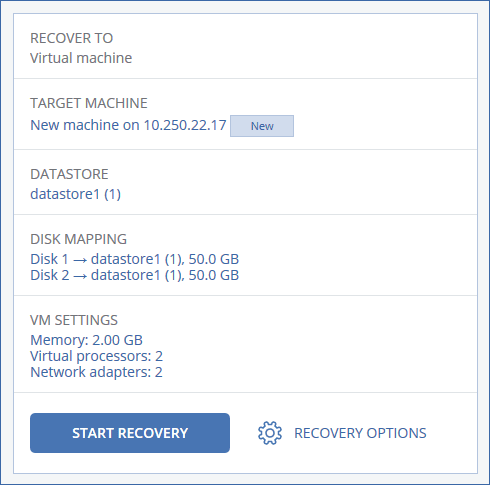Recovering a virtual machine
You can recover a backup of a virtual machine to a physical machine or to another virtual machine.
Recovering to a virtual machine is possible if at least one agent for the relevant target hypervisor is installed in your environment and registered on the management server. For example, recovery to VMware ESXi requires that Agent for VMware is installed in the environment and registered on the management server.
Some options are only available with the cloud deployment.
For more information about the supported paths for virtual-to-physical (V2P) or virtual-to-virtual (V2V) machine migration, refer to Machine migration.
To recover a virtual machine
-
Do one of the following:
- Select a backed-up machine, click Recovery, and then select a recovery point.
- Select a recovery point on the Backup storage tab.
- Click Recover > Entire machine.
-
[When recovering to a physical machine] In Recover to, select Physical machine.
Recovery to a physical machine is possible only if the disk configuration of the target machine matches exactly the disk configuration in the backup. If this is the case, continue to step 4 in Recovering a physical machine. Otherwise, we recommend that you perform the virtual-to-physical (V2P) migration by using the bootable media.
-
By default, the original machine is selected as a target machine. To recover to another virtual machine, click Target machine, and then do the following:
-
Select the hypervisor.
At least one agent for that hypervisor must be installed in your environment and registered on the management server. - Select whether to recover to a new or existing machine.
- Select the host, and then specify the new machine name, or select an existing target machine.
- Click OK.
-
- [For Virtuozzo Hybrid Infrastructure] Click VM settings, and then select Flavor. Optionally, you can change the memory size, the number of processors, and the network connections of the virtual machine.
-
[When recovering to a new machine] Configure the additional recovery options that you need:
-
[Not available for Virtuozzo Hybrid Infrastructure and Scale Computing HC3] To select the datastore for the virtual machine, click Datastore for ESXi, Path for Hyper-V and Virtuozzo, or Storage domain for Red Hat Virtualization (oVirt), and then select the datastore (storage) for the virtual machine.
-
To select the datastore (storage), interface, and the provisioning mode for each virtual disk, click Disk mapping. In the mapping section, you can choose individual disks for recovery.
You can not change these settings if you are recovering a Virtuozzo container or Virtuozzo Hybrid Infrastructure virtual machine. For Virtuozzo Hybrid Infrastructure, you can only select the storage policy for the target disks. To do so, select the desired target disk, and then click Change. In the blade that opens, click the gear icon, select the storage policy, and then click Done. -
[Available for VMware ESXi, Hyper-V, Virtuozzo, and Red Hat Virtualization/oVirt] To change the memory size, the number of processors, and the network connections of the virtual machine, click VM settings.

-
- Click Start recovery.
- [When recovering to an existing virtual machine] Confirm that you want to overwrite the disks.
The recovery progress is shown on the Activities tab.